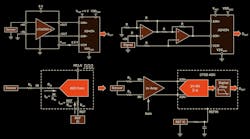Members Only Content
CTSD Precision ADCs (Part 4): Ease of ADC Input and Reference Drive Simplify Signal-Chain Design (Download)
March 16, 2022
The key to achieving optimal signal chain performance is ensuring that the input source or the reference itself isn’t corrupted when interfaced with an analog-to-digital converter (ADC). With traditional ADCs, complex signal-condition circuitry design, otherwise referred to as front-end design, is required for the seamless interface of input and reference to the ADC.
The unique architectural properties of continuous-time sigma-delta (CTSD) ADCs enable simplified and innovative ways of interfacing this ADC to the input and reference. To begin, let’s quickly recap traditional ADC front-end designs.
Comments
Comments
